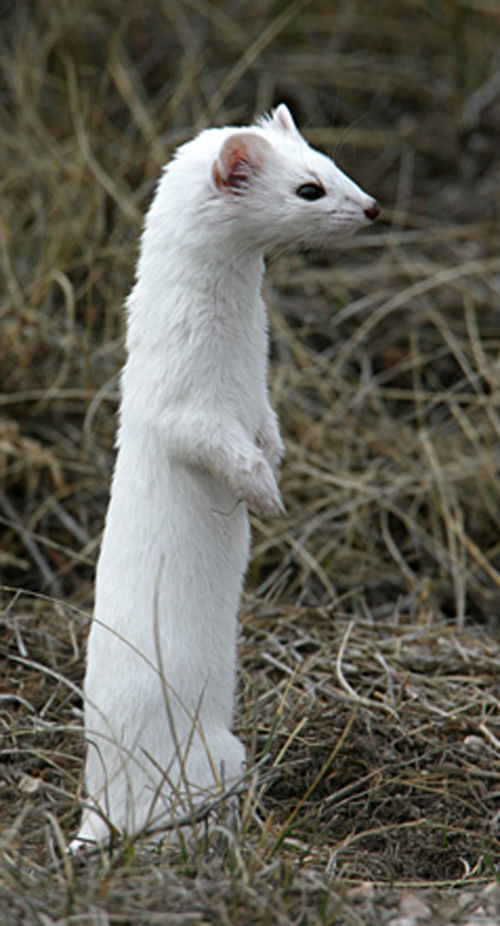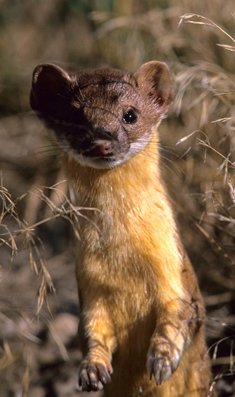The genus Mustela is one of nine genera and 16 species belonging to the family Mustelidae that are found in North America north of Mexico. Its family tree includes the wolverine (Gulo gulo), the skunk (Mephitis mephitis), and the badger (Taxidea taxus). The genus name Mustela probably comes from the Latin word for mouse, with which its bearer shares only a few physical features.
The specific epithet frenata, which is Latin for bridle, refers to the facial feature in the dark summer phase that resembles a pair of reins. In length this lithe little carnivore, weighing in at a mere 10 ounces at most, can be 22 inches in length, plus a three- to six-inch black-tipped tail, all carried close to the ground by legs only one or two inches long. Its summer name is stoat; in winter it’s an ermine. Its privileged black-tipped tails once were traditional trimmings on the robes of kings.
One of Nature’s little people, the weasel has a voice to match its size—a discreet little screech or squeal, a soft rippling trill, and even a wisp of a purr. Its favorite fast food is a mouse or a vole, but on special occasions it will relish a rabbit, chipmunk, shrew, rat, snake, frog, bird, or even ordinary chicken. In northern latitudes, from late April to early October, it is brown with white underparts and brownish feet. From December to February it is pure white except fora its usual black eyes and nose, and the black tip on its tail. That’s when the weasel is known as an ermine.[1]John O. Whitaker, Jr., ed., National Audubon Society Field Guide to North American Mammals, 2d ed. (New York: Alfred A. Knopf, 1996), 761-64.
Expedition Encounters
The captains saw their first white weasel “(Taile excepted which was black at the end)” at Fort Mandan on 9 November 1804. Its pelt may have been among those in “Package No. 11” that they shipped back East the following April.[2]Moulton, Journals, 3:232, 330. On 14 August 1805, during aid negotiations with the Lemhi Shoshone, Lewis promised Cameahwait that his people would soon be able to satisfy their needs from American traders “in exchange for the skins of the beaver Otter and Ermin so abundant in their country.” At Fort Clatsop on Christmas Day, 1805, Sacagawea gave Clark “2 Doz wesels tales,” though there is no hint of when, where or how she got them. En route home on 17 April 1806, near present The Dalles, Oregon, her husband Charbonneau bargained for a horse with “Hurmen [Clark undoubtedly meant “ermine”], Elks Teeth, a belt and Some other articles of no great value.”]
Poor Reputation
From at least the beginnings of Indo-European languages, this creature has been called by a name variously spelled but sounding something like weasel. Noah Webster, in his Compendious Dictionary of the English Language (1806), defined weasel—he preferred the spelling weesel—as “a genus of quadrapeds with slender bodies.” Webster knew it also as an ermelin, “a small animal with delicate white fur.”
Over many generations its common name has come to be synonymous with a large, uncomplimentary vocabulary of English-language insults, perhaps because of its owner’s size, elusive manner, secretive lifestyle, and perhaps above all for its ability to change colors for self protection. Consider its synonyms: “to get out of (as in “weasel out”), worm out of, sneak out of, shuffle out of, sleaze out of; evade, get by or around, avoid, dodge, duck, fudge; hedge, fence, not commit oneself, equivocate, doubletalk, waffle, beat around the bush, skirt the issue, not give a straight answer, hem and haw, beg the question.”
The list goes on and on: “evasive, hedging, mealy-mouthed, noncommital, equivocal, ambiguous, vague; indirect, circuitous, roundabout, circumlocutory, periophrastic; misleading, deceiving, deceptive, tricky, oversubtle, sophistical, casuistic, casuistical; elusive, smooth, clever, slippery, shifty, dodgy.”[3]Jerome I. Rodale, The Synonym Finder (rev. ed., Emmaus, Pennsylvania: Rodale Press, 1978), 1338. A “weasel word”—inspired by the animal’s supposed talent for sucking the innards out of an eggshell—is an equivocation intended to diminish the force of a statement, or to avoid a commitment. All this adds up to a very heavy mantle of bad karma for so small, cute, loveable, and seasonally beautiful an animal to bear.


